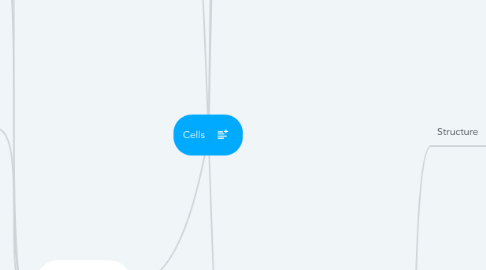
1. Extracellular Materials
1.1. Extracellular Fluid
1.1.1. Interstitial Fluid
1.1.2. Blood Plasma
1.1.3. Cerebrospinal Fluid
1.2. Cellular Secretions
1.2.1. Digestive Fluids
1.2.1.1. Intestinal & Gastric Fluids
1.2.2. Lubricants
1.2.2.1. Saliva
1.2.2.2. Mucus
1.2.2.3. Serous Fluids
1.3. Extracellular Matrix
2. Cell Cycle
2.1. Interphase
2.1.1. G1 Phase
2.1.1.1. Normal Cell Activity
2.1.1.2. CHECKPOINT
2.1.2. S Phase
2.1.2.1. DNA Replication
2.1.2.1.1. Replication Bubble forms
2.1.2.1.2. Replication Fork is apparent
2.1.2.1.3. DNA Polymerase forms leading/lagging strands
2.1.2.1.4. Ligare restores DNA helix structure
2.1.3. G2 Phase
2.1.3.1. CHECKPOINT
2.1.3.1.1. Is DNA replicated properly?
2.2. Mitotic Phase (cell division)
2.2.1. Mitosis
2.2.2. Cytokinesis
2.2.2.1. Begins in late Ana
2.2.2.2. Contractile ring forms a Cleavage Furrow
2.2.2.3. Daughter cells enter into interphase
2.3. DNA
2.3.1. Four Nucleotide Bases "LETTERS"
2.3.1.1. Triplets "WORDS"
2.3.1.1.1. Amino Acids "SENTENCES"
2.3.1.2. Types
2.3.1.2.1. A
2.3.1.2.2. G
2.3.1.2.3. T
2.3.1.2.4. C
2.3.2. Exons
2.3.2.1. Coding Regions
2.3.3. Introns
2.3.3.1. Non-coding Regions
2.3.4. NEVER leaves the nucleus
2.4. RNA
2.4.1. Structure
2.4.1.1. U instead of T
2.4.1.2. Sugar Ribose
2.4.1.3. Single-Stranded
2.4.2. Types
2.4.2.1. mRNA
2.4.2.1.1. carries coded info to the cytoplasm
2.4.2.2. rRNA
2.4.2.2.1. forms ribosomes
2.4.2.3. tRNA
2.4.2.3.1. move amino acids to the ribosomes
2.4.2.3.2. mRNAs message will be decoded
2.5. Polypeptide Synthesis
2.5.1. Transcription (NUCLEUS)
2.5.1.1. Basic : DNA info -> mRNA
2.5.1.2. Transcription factors must bind to the Promoter
2.5.1.2.1. Template Strand
2.5.1.2.2. Coding Strand
2.5.1.3. RNA Polymerase binds to promoter
2.5.1.3.1. Initiating mRNA sythesis
2.5.1.4. Elongation of mRNA
2.5.1.4.1. RNA nucleotides that compliments the DNA
2.5.1.5. Termination
2.5.1.5.1. Polymerase reaches termination signal
2.5.1.6. Spliceosomes remove introns
2.5.1.6.1. Entrons = functional mRNA
2.5.2. Translation (CYTOSOL)
2.5.2.1. Basic : mRNA info is decoded and used to make polypeptides
2.5.2.2. mRNA is made of codons
2.5.2.2.1. a three-base sequence
2.5.2.3. tRNA picks up an amino acid & a codon
2.5.2.3.1. it also has an anticodon
2.5.2.4. ribomes act like an attachment site
2.5.2.4.1. one binding site for mRNA
2.5.2.4.2. three binding sites for tRNA
3. Nucleus
3.1. Structure
3.1.1. Nuclear Envelope
3.1.1.1. double-membrane barrier
3.1.1.1.1. outer layer
3.1.1.1.2. inner layer
3.1.1.2. nuclear pores
3.1.1.3. nucleoplasm
3.1.2. Nucleoli (NO MEMBRANE)
3.1.2.1. assembles ribosomal subunits
3.1.3. Chromatin
3.1.3.1. Structure
3.1.3.1.1. RNA 10%
3.1.3.1.2. Histone Proteins 60%
3.1.3.1.3. DNA 30%
4. Cytoplasm
4.1. Structure
4.1.1. Cytosol
4.1.1.1. Viscous, semitransparent fluid
4.1.2. Organelles
4.1.2.1. Mitochondria
4.1.2.1.1. Has 2 Membranes
4.1.2.2. Ribosomes
4.1.2.2.1. Made Of 2 Subunits
4.1.2.2.2. Free Ribosomes
4.1.2.2.3. Membrane-Bound Ribosomes
4.1.2.3. Endoplasmic Reticulum
4.1.2.3.1. Rough ER
4.1.2.3.2. Smooth ER
4.1.2.4. Golgi Apparatus
4.1.2.4.1. "Traffic Director"
4.1.2.5. Peroxisomes
4.1.2.5.1. Oxidases Enzyme
4.1.2.5.2. Catalases Enzyme
4.1.2.6. Lysosomes
4.1.2.6.1. Disgest & Degrade
4.1.2.7. Cytoskeleton (NO MEMBRANE)
4.1.2.7.1. Types of Rods
4.1.2.8. Centrosome & Centrioles
4.1.2.8.1. "Microtubule Organzing Center"
4.1.2.8.2. Organizes mitotic spindle
4.1.2.8.3. Form
4.1.3. Inclusions
4.1.3.1. Chemical Substances
5. Plasma Membrane
5.1. Structure
5.1.1. Phospholipids
5.1.1.1. Hydrophilic Heads
5.1.1.1.1. Phosphate Group
5.1.1.2. Hydrophobic Tails
5.1.1.2.1. Fatty Acids
5.1.2. Cholesterol (20%)
5.1.2.1. Hydroxyl Group (Polar)
5.1.2.2. Fused Ring System (Nonpolar)
5.1.3. Membrane Proteins (50%)
5.1.3.1. Integral Proteins
5.1.3.1.1. Structure
5.1.3.1.2. Function
5.1.3.2. Peripheral Proteins
5.1.3.2.1. Structure
5.1.3.2.2. Function
5.1.3.3. Cell Junctions
5.1.3.3.1. Tight Junctions ("Ziploc")
5.1.3.3.2. Desmosomes ("Velcro")
5.1.3.3.3. Gap Junctions ("Telephone")
5.1.4. Carbohydrates
5.1.4.1. Glycolipids
5.1.4.2. Glycoproteins
5.1.4.2.1. Acts as Cell Adhesion Molecules
5.1.4.3. Glycocalyx
5.1.4.3.1. Provides ID
5.2. Function
5.2.1. Transport of Substances
5.2.1.1. Passive Transport
5.2.1.1.1. Types
5.2.1.1.2. Speed?
5.2.1.2. Active Transport
5.2.1.2.1. Types
5.2.1.2.2. Move against concentration gradient
5.3. What Can Pass Through?
5.3.1. Small Molecules
5.3.2. Lipid Soluble Molecules
5.4. Membrane Potential
5.4.1. Resting MP
5.4.1.1. -50 to -90 mV
5.4.1.2. inside of cell is more negative
5.4.1.3. How is this determined?
5.4.1.3.1. Concentration gradient of K+
5.4.1.3.2. Permeability of the P.M. to K+
5.4.1.3.3. Concentration gradient of Na+

